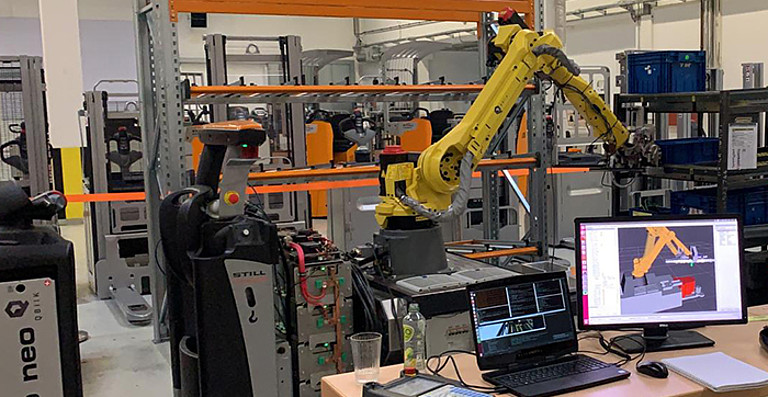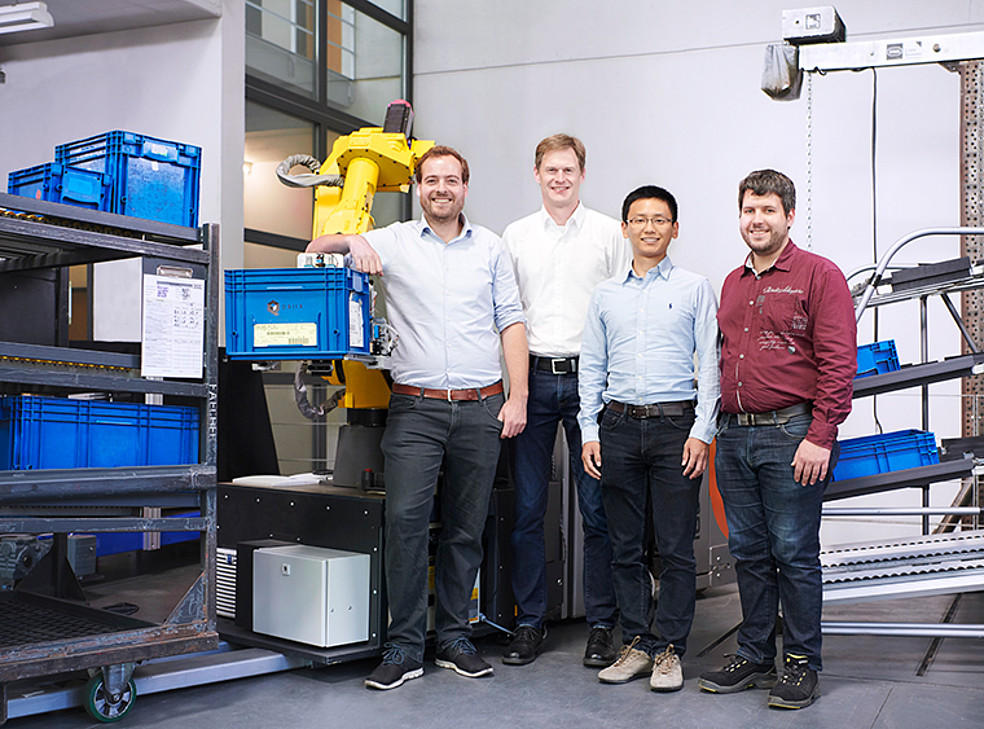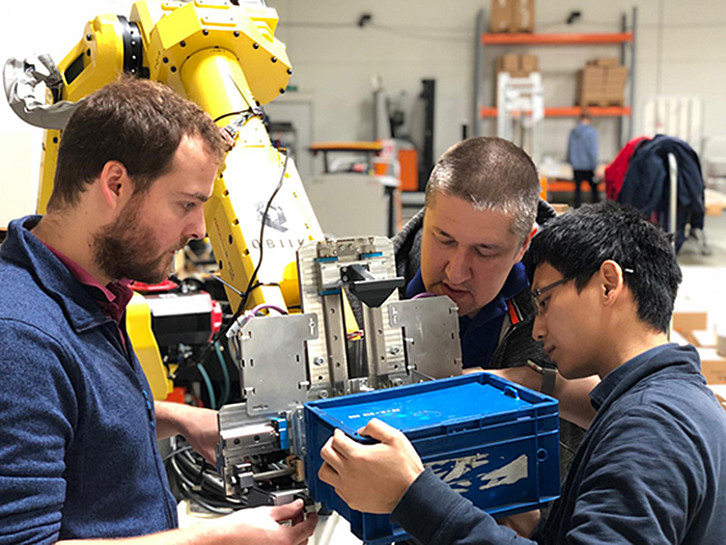Published on November 12, 2019
Pick and grip with QBIIK
Text | Subline und Lorem Ipsum
Schema Blabla
Driverless logistics vehicles that independently navigate goods through warehouses with countless meters of shelves are no longer a rarity in modern logistics centers. Often, these vehicles are completely autonomous on their way without coming into contact with employees. When the paths of human and machine cross, safety measures such as fences, light barriers or personal safety scanners help to avoid collisions and accidents. The BMWi-funded QBIIK project proved how humans and logistics robots can complement each other and interact reasonably in the future.
Since 2017, two research groups at KIT, the Institute of Materials Handling and Logistics Systems (IFL) and the Institute of Anthropomatics and Robotics (IAR), have been working together with industrial partners to develop an autonomous, adaptive logistics robot through to pilot deployment. The project consortium is completed by Audi Sport GmbH, Bär Automation GmbH and STILL GmbH. QBIIK project manager Jonathan Dziedzitz from IFL reports with satisfaction: "Over the past two years we have created a novel collaborative logistics platform that usefully combines the technology of autonomous systems with human capabilities using teleoperation".
Optimizing replenishment procurement
In order to develop QBIIK under realistic requirements, a deployment scenario from Audi Sport served as the development framework. Gerrit Flüssmeyer, who is responsible for logistical process planning at the Heilbronn-based car manufacturer, describes the use case: "To ensure that our assembly workers always have sufficient quantities of the right material available at the assembly workplace for the small series of the Audi R8, components are picked several times a day from the central warehouse in boxes in so-called small load carriers (KLT in German) on fan-shaped carts and transported to the point of use. So far, the replenishment boxes have been loaded and distributed by hand." The demand for efficiency and at the same time physical relief for the employees is the motivation to automate such sub-processes using robotics. An autonomous picking system such as QBIIK could bring considerable relief.
Moving loads autonomously
QBIIK consists of an autonomous logistics vehicle on which an industrial robot with a tactile gripper is mounted. The system performs all basic operations autonomously: The vehicle orientates itself independently in the room and navigates to its destination, finds the right shelves, grips the required boxes of goods and finally transports them to the supermarket of the automobile manufacturer. Here, the KLTs are automatically removed from the trailer and transferred to standard flow racks in the assembly line. Alexander Pollmann, construction engineer at Bär Automation, describes the specific feature: "We wanted to develop a system that is really capable of carrying heavily loaded KLTs and thus provides real relief for people". Normally, significantly smaller robots are installed on mobile platforms that handle individual parts. In contrast, the jointed-arm robot built into QBIIK is capable of handling various KLTs with a maximum weight of up to 15 kilograms.
Everything in the Grip
With the definition of the area of use, the boundary conditions were also given: The task was to grip KLTs of different sizes and orientation fully automatically. "No gripper available on the market could cope with the high variance of the KLTs in combination with the maximum possible weight. The solution was a completely new development of a gripper that meets our requirements," explains Pollmann. With the help of the QBIIK gripper, the different KLTs can be gripped both lengthwise and crosswise. In addition, the load carrier is supported by rails on the underside due to its high weight.
The box detection and gripping point determination is carried out via a multi-stage system, which was significantly developed at the IAR. Dziedzitz reports: "An artificial neuronal network recognizes the box to be gripped and other properties required for the gripping process. In addition to imaging sensors, a combination of a 3D camera and tactile proximity sensors is used. These sensors determine the exact position of the box in the room and the start position of the robot". One challenge was the compact integration of the required electronic components for controlling the robot and the gripper. With its expertise as a special machine manufacturer, Bär Automation was responsible for system integration. A well thought-out system architecture combines purchased components, in-house designs and sensor technology developed in-house in a complete platform to form a new, autonomous order picking system.
Human-machine interaction
"The basic idea was that we regard the human being as an assistant to the autonomous system," emphasizes Dziedzitz, who had a full focus on teleoperation in the project. "If a situation occurs that is unknown to QBIIK, the system pauses to avoid a malfunction or failure of the system and requests human assistance. Such unknown occurrences could be jammed boxes, a missing label or a slanting shelf. A novel anomaly detection has been implemented for situation analysis, which evaluates the situation based on the available sensor signals. The "call for help" initiates the interaction of the robot with the human being according to the principle of teleoperation. A complex human-machine interface bridges the spatial distance in real time so that a human operator can analyze the situation from a completely different location - either via virtual reality glasses or via a screen.
With the appropriate technical equipment, QBIIK is then telecontrolled by the operator. The teleoperator executes the gripping process by transferring the arm movements directly to the robot's gripper arm. In this way, the movement is carried out by the operator, but is performed remotely by the robot. Dziedzitz underlines: "The human intelligence to recognize things and to act accordingly is transferred one-to-one to the machine by the teleoperation". QBIIK has the ability to learn at each operator interaction by generating learning data at each telecontrol to improve the system. If the situation occurs again, QBIIK should then be able to carry out the working steps independently. If the teleoperator was able to solve the situations, QBIIK returns to autonomous operation. The operator dedicates himself again to his everyday business.
Safety first
As with all robots that are used in an environment with humans, very high requirements are placed on occupational safety. In view of the heavy industrial robot used at QBIIK, actions to protect humans have the highest priority. Dziedzitz explains the dimensions: "Including the trailer, the demonstrator measures a total length of 6.5 meters. With a total weight of up to 3.5 tons, it is critical from a safety point of view that the trailer can move freely." Here, the engineers have taken a number of measures to ensure safety. In addition to an actively controlled coupling, QBIIK is surrounded by a virtual protective fence that continuously monitors the required safety distance. In order to be able to operate the entire demonstrator safely, a risk analysis was also made. The company STILL was in charge here. A total of 116 dangers were identified and appropriate measures for prevention were defined. The topic of occupational safety in particular showed in the project that there are still a lot of unanswered questions.
Goods logistics with foresight
At the end of this year, the joint project will culminate in a pilot phase at the Audi Sport manufactory, where all the components will interact. Here, the automated replenishment process with QBIIK will take place in a realistic pilot environment in order to obtain important data on the long-term use, teleoperation and learning capability of the system. "We are following different approaches from Industry 4.0 to reduce manual effort in the plant. QBIIK has the potential to optimize replenishment in the medium term. In this project, we are gaining initial experience with intensive human-machine communication with autonomous robots," concludes process manager Flüssmeyer.
"We looked at a very individual process and automated it with as little intervention as possible. However, the intelligent, adaptive QBIIK logistics robot could also make other processes more efficient in the future - wherever shelves have to be filled," says the project manager Dziedzitz. In particular, the potential of VR teleoperation can be transferred to any autonomous robotic system. "At the moment, it is a kind of bridging technology that gives an idea of how useful autonomous systems could be in collaboration with humans at some point in the future," Dziedzitz continues. The accumulated expertise in sensor-based recognition and robust gripping of various objects expands the system's application possibilities in order picking.




comments about this article
No comments